Heidelberg is known as one of the important university towns of Germany, with its university founded in 1386. Millions of tourists flock to this city to visit its Altstadt (the old city) and the castle, which remained intact through World War II. The location on either side of the Neckar river as it exits the Odenwald hills and enters the Rhine plain adds greatly to the beauty of the city (an excellent video of the river as it enters and exits Heidelberg can be seen here). And as befits a culturally vibrant city with a strong university community, it has a lot of sharing ventures to offer, which I have been able to explore in the last three years that I have lived here. Here are some highlights.
1. The Hills and Forest
A castle in Germany's Heidelberg, located among forested hills alongside the Neckar river. Photo by Ishita Ghosh
Reflecting my background as a geographer, I will begin with the landscape setting. The Odenwald hills that I just mentioned are nowadays mostly covered in forest (back in the Medieval period, the hills near Heidelberg were used as common pastureland and were mostly covered in grass, as documented in a famous print by Matthäus Merian from 1620). The forests, which can be easily reached by foot from the city, are crisscrossed by numerous trails where people go walking, jogging, mountain biking and so forth — it is a typical German "stadtwald" (city forest) that the residents of the city share.
In the fall, some people go out and collect the chestnuts that are abundant here, to roast or otherwise consume at home. Commercial collection of chestnuts is not allowed — one is only allowed to collect for one's own use. Other edible plant species are also found in the forest; for example, at certain sites "bärlauch" (wild garlic) grows in profusion in early spring, before the trees have grown their foliage. Some people are consciously reviving knowledge about herbs like these, and collecting them for their own use. And so, through the centuries, the hills have remained an important commons for the people of the city.
2. Flowing Water

Collecting drinking water at a spring near Heidelberg. Photo by Wolfgang Hoeschele/Shareable
Heidelberg would not be Heidelberg without the Neckar river. The Neckarwiese (Neckar meadow), a grassy area on the north shore of the river, is used by people of all walks of life and of all cultural backgrounds as a recreation area, for grilling, ballgames, and more. The river itself is used for rowing (an important sport here), and some side branches are used for swimming. However, a heavily trafficked road on the south shore separates the old city from the waterfront — many people who yearn for better access to the river have campaigned for putting that road underground, but this seems unlikely in the foreseeable future due to the high costs. On a less ambitious scale, there is a group called Neckarorte that seeks to promote better access to the river wherever that is possible.
But the springs and creeks that feed the Neckar from the surrounding hills must not be neglected. The water from Ziegelhausen (now a suburb of Heidelberg) has long been renowned as being of especially high quality; laundries used to be located there. Nowadays, while everyone has piped water (fed by a mix of local and regional sources), some people prefer to drink pure water from a source they know. They go and collect water from several springs surrounding Heidelberg, one of them upstream from Ziegelhausen, others on the slopes of the Königstuhl or the Heiligenberg hills, another (shown in the picture) right next to the Neckar a few miles upstream of the city. At this last spring, which is very easily accessible, cars are lined up at almost all times of day, with people who have brought large numbers of water jugs waiting for their turn to fill them.
3. The Philosophenweg
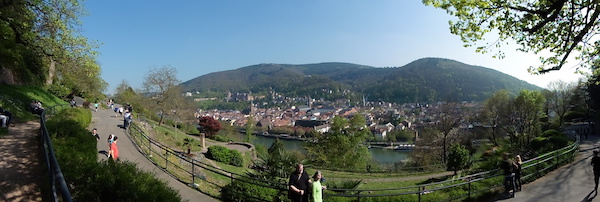
The Philosophenweg with its view of Heidelberg in early spring. Photo by Wolfgang Hoeschele/Shareable
The Philosophenweg (philosopher's path) was made famous by Romantic poets because of the excellent view of Heidelberg it affords, looking down on the city from the hill slope on the other side of the river. Like all public paths, it is shared. What makes it somewhat exceptional is that it is equally popular among tourists and residents of the city. What is more exceptional is the vigor with which its qualities are defended by the city residents.
This became apparent to me in the spring of 2015, when the city administration had an additional bar added to a railing along this path, justified as being necessary for the safety of cyclists (even though one is not supposed to cycle here). This became a hot topic in articles and letters to the editor in the local newspaper, because the bar was ugly and obstructed people’s view of the city. Within a few weeks, the city felt obliged to pull down the bar and redo their design. An excellent example of citizens asserting their shared ownership of their view of the city.
4. Electric Power
Solar array installed by the Energiegenossenschaft Heidelberg on the rooftops of a cooperative housing tract. The solar array belongs to members of the housing cooperative. Photo courtesy of Energiegenossenschaft Heidelberg
Sharing in Heidelberg of course does not just include access to the landscape setting. I will now turn to some items that consume a large portion of every household’s budget – energy, housing, food, and mobility. The electric current and district heating in the city of Heidelberg is supplied by the Stadtwerke Heidelberg, a municipally owned company which also handles the water supply and other public works, as well as local swimming pools. They are working on consistently expanding renewable energy supplies and offer customers the opportunity to purchase 100 percent renewable power. Beyond this, there are two interesting local ways to share in promoting the "Energiewende" (energy transition) to efficient use of renewable energy.
One is by membership in the Heidelberger Energiegenossenschaft, a cooperative which operates its own photovoltaic arrays, owns shares in two wind power projects in the region, helps organize renters to install shared solar arrays on the rooftops of the buildings where they live, and sells power to consumers — sourced exclusively from renewable energy cooperatives and from water power facilities. Although physically the power comes from the same sources as one’s neighbors, the money to pay for that power goes to the cooperative renewable energy providers, helping to finance a shift to decentralized production of renewable power. In fact, Heidelberg is home not only to its own energy cooperative, but also to the Bürgerwerke, the national federation of such cooperatives which have built up a national network to supply each other with electric current.
The other way to participate in the Energiewende is by buying one's electric power from the Klimaschutz-Plus-Stiftung, or its offshoot, the Heidelberger Solidarstrom, where the power comes from one of the German pioneers in cooperatively owned energy production (the Elektrizitätwerke Schönau). The annual surplus is divided between supporting further investment in renewable energy, and sustainable development projects in Germany and abroad. Every year, the members/customers propose and vote on which projects to support.
5. Shared Housing
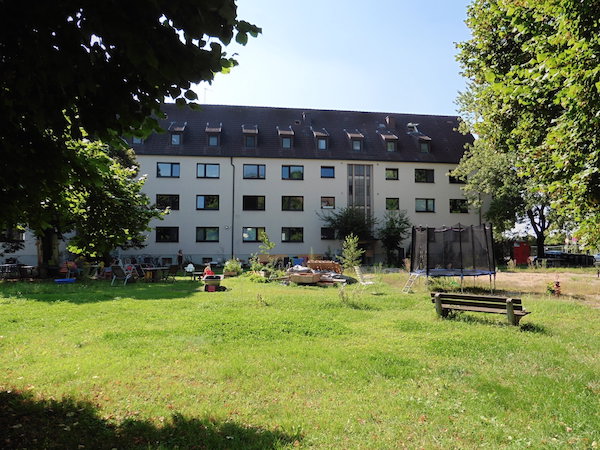
Former U.S. Army barracks now being renovated by the Hagebutze housing cooperative. Photo by Wolfgang Hoeschele/Shareable
In German cities, the majority of people live in rented apartments. In Heidelberg, the rental market is very tight, and rents are not far below the peaks found in Munich or Frankfurt. Luckily, there are housing cooperatives, mostly established soon after WWII, that own and operate over 10,000 housing units at a modest rent in the interest of their members (this accounts for somewhere between a quarter and a third of the resident population). There are long waiting lists to get apartments through them. It is a form of shared ownership of housing, though decision-making appears to be quite distant from the ordinary members.
Recent developments are taking shared housing a few steps further, however. As the HQ of the US Armed Forces in Germany was closed a few years ago, large barracks in Heidelberg and Mannheim (Heidelberg’s larger and more industrial neighbor) have become available for housing developments. Some of these buildings have been purchased by groups of people who have joined together to form co-housing ventures. The largest, an existing body of university students called "Collegium Academicum," plans to establish cooperatively administered housing for 200 students. Others, such as konvisionär and Hagebutze, are groups ranging from 25 to over 50 people, who wish to collaboratively redesign and occupy the buildings they will live in. All have designed ownership structures that ensure that nobody can sell off their share at a high price – which means that rents will remain permanently low. They have also put a lot of thought into creating shared spaces that reduce their overall need for space, as well as facilities that are open to the larger community (such as a bike repair shop, meeting spaces, a drop-off point for the solidarity agriculture community mentioned in the next section). To complement and facilitate conventional bank loans, they are raising funds by soliciting low or zero-interest loans from members of the community. Thus, they are exploring new methods of shared housing for several hundred people in the city.
6. Food

Essbares Heidelberg garden, located at a tram station next to a church. Photo by Wolfgang Hoeschele/Shareable
The Heidelberg chapter of the German organization "foodsharing" is also quite active. They collect food from grocery stores and other food-related businesses that would otherwise be thrown away, but that is still in good condition. They then place it in specific spots where people who want it can pick it up.
7. Mobility
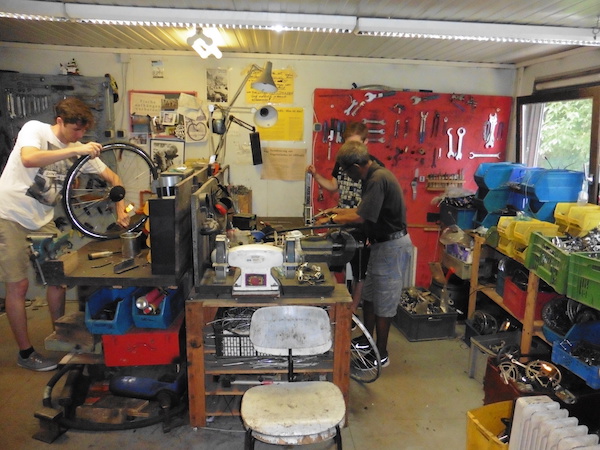
The URRmEL bike co-op. Photo by Wolfgang Hoeschele/Shareable
Bicycle traffic is counted by the city at several locations; the data are made public online. Bicycle use is supported by sharing ventures. University students run a cooperative bike repair shop where people can repair their own bikes and get instructions if needed. There is also a Radhof (bike repair shop) which provides jobs for people who have been unemployed for a long time, as a way back into the regular job market. They have a huge amount of used parts available to get old bikes into shape again. In addition, they support cycling in Rwanda and South Africa (in Ratanda, a township belonging to Heidelberg, South Africa) by collecting used bikes and spare parts and shipping them to workshops there, in cooperation with the charitable organization Voices for Africa. Finally, a bike sharing venture called Nextbike has recently been started in Heidelberg and Mannheim.
8. Books and Information
In the university town of Heidelberg, education plays a major role. I am writing this piece in Heidelberg’s public library, which I use as a kind of subsidiary office. It is a popular place to check out books, read newspapers, access the Internet (one of the 170 locations where one can access free public Internet in the city), study or attend public events. Residents can also use the university library for a very modest annual fee. Book sharing in public places is promoted by a local citizen’s foundation (the Bürgerstiftung Heidelberg), which has set up bookshelves protected from the rain in several places in the city. Whoever wishes to can leave old books there, or take away books left there by others. Volunteers check by regularly to make sure that the bookshelves remain clean and orderly.
9. Art and Creative Enterprise
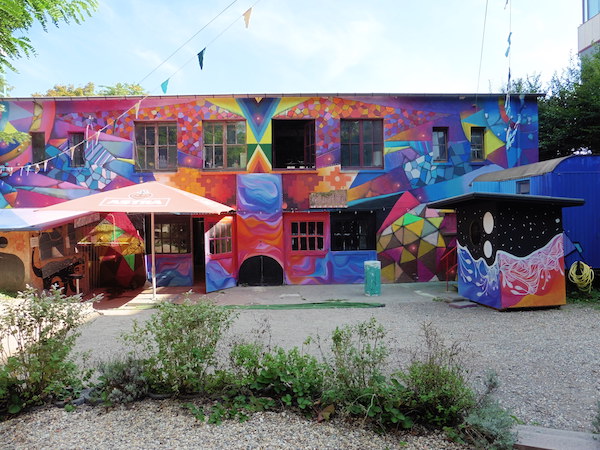
The Breidenbach Studio which provides shared spaces for artists, by Wolfgang Hoeschele
Heidelberg seeks to support creative enterprise and the arts in several ways. Some of them reflect a spirit of sharing. There are two places where artists and other creative entrepreneurs can rent spaces and have the opportunity to interact with each other — the Breidenbach Studios (in a former facility to fill bottles with natural gas) and the Dezernat 16. Both are supported by the city administration, the former mainly by making cheap studio places available, the latter by subsidized office spaces, a coworking space, and a variety of programs in support of creative entrepreneurs.
In a more publicly visible way, since 2015 there has been an annual Metropolink Festival in Heidelberg. As part of this festival, every summer murals are painted on several buildings in the city, which become part of the shared art of the city. In a makerspace hosted by the Deutsch-Amerikanische Institut (German-American cultural center), people meet every Wednesday to make things using a variety of tools and 3D printers.
10. Transition Town
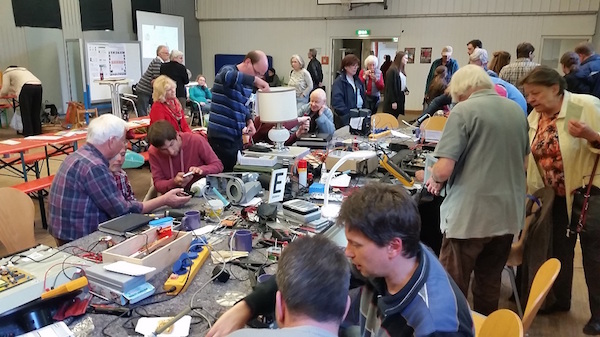
A repair café organized by Transition Town in cooperation with other organizations in Heidelberg. Photo courtesy of Transition Town Heidelberg
Sharing is at the core of Transition Town activities worldwide, and the active Transition Town chapter in Heidelberg is no exception. The group, which usually meets in the Breidenbach Studios just mentioned, regularly organizes repair cafés, where people can have broken things — bikes, electronic equipment, clothes etc. — repaired by volunteers, while also enjoying coffee and cake. Transition Town helped launch the "Leih- und Umsonstladen" — the "borrow and free shop." Long-lived items that one typically uses only occasionally, such as power tools, can be lent to the shop in return for the ability to borrow similar things oneself. The other option is to simply give things one no longer needs — which are then available free of charge.
The chapter is currently hard at work on two new projects, which appear like they are going to receive government funding for the next two years. One is a "WandelKulturHaus" — a house fostering a culture of change toward a more ecologically and socially sustainable lifestyle. The idea is to have a noncommercial space for cultural events, holding meetings, workshops, cooking together, discussion and chatting, for personal encounters. The other is a permaculture garden, open for the surrounding community, that offers opportunities to practice more resource-conserving activities by gardening, but also by participating in workshops and other events. Both of these are meant to foster a culture of sharing.
11. Sharing with Refugees

Each1Teach1 members. Photo courtesy of the Sweet Home Project
Sharing is especially important when people face a crisis situation, and 2015 was an especially critical year for many millions of people in several African and Middle Eastern countries. Close to a million sought refuge in Germany. Initially, there was an unprecedented outpouring of support for refugees from war and political repression, all across Germany, including Heidelberg. People gave clothing, food, and many other items to the refugees, and made places available for them to temporarily stay. Unfortunately, this was followed by backlash against refugee populations.
However, countless local groups in Heidelberg and across Germany have continued to help refugees — both new arrivals and the people who arrived in years past. Some have imbued this help with a spirit of sharing both ways. An excellent example is the Sweet Home Project in Heidelberg. A group of refugees cooks a meal every Monday using donated food, for a shared dinner, conversation, and music with other residents of the city. Members of the group also perform music at various venues. This is one project of "Each1Teach1," which creates opportunities for learning among Heidelberg residents and refugees.
Altogether, Heidelberg's sharing opportunities cover many aspects of life. They are creatively adapted to address new issues, and to address the needs of diverse residents, whether they have lived here a short or long time, and regardless of the reasons why they have come to this city.
Header photo of one of the first murals of the Metropolink Festival, by Wolfgang Hoeschele/Shareable









